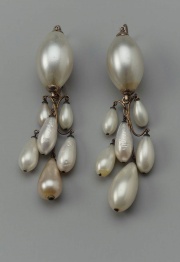Difference between revisions of "Imitation pearl"
Jump to navigation
Jump to search
m (Text replace - "== Authority ==" to "== Sources Checked for Data in Record ==") |
|||
| Line 8: | Line 8: | ||
artificial pearl; guanine; perle artificielle (Fr.); imitatie parel (Ned.); pérola artificial (Port.) | artificial pearl; guanine; perle artificielle (Fr.); imitatie parel (Ned.); pérola artificial (Port.) | ||
| − | == | + | == Sources Checked for Data in Record == |
* George Savage, ''Art and Antique Restorer's Handbook'', Rockliff Publishing Corp, London, 1954 | * George Savage, ''Art and Antique Restorer's Handbook'', Rockliff Publishing Corp, London, 1954 | ||
Revision as of 05:35, 1 May 2016
Description
An inexpensive, imitation Gemstone. Artificial pearls, first made in the 19th century, were constructed by injecting hollow beads of Glass with a mixture of aqueous ammonia and fish scales. This deposited a layer of Guanine crystals as an iridescent film on the interior surface of the beads. In the 20th century, another process made imitation pearls by coating the exterior of solid glass beads with the fish scale mixture. The nacreous coating was sealed with a protective Varnish layer.
Synonyms and Related Terms
artificial pearl; guanine; perle artificielle (Fr.); imitatie parel (Ned.); pérola artificial (Port.)
Sources Checked for Data in Record
- George Savage, Art and Antique Restorer's Handbook, Rockliff Publishing Corp, London, 1954
